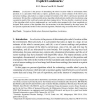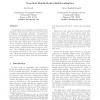152 search results - page 29 / 31 » Estimating the Pose of a 3D Sensor in a Non-rigid Environmen... |
IJRR
2002
13 years 7 months ago
2002
A key component of a mobile robot system is the ability to localize itself accurately and, simultaneously, to build a map of the environment. Most of the existing algorithms are b...
ICRA
2009
IEEE
13 years 5 months ago
2009
IEEE
Abstract-- A main difficulty that arises in the context of probabilistic localization is the design of an appropriate observation model, i.e., determining the likelihood of a senso...
ALGORITHMICA
2000
13 years 7 months ago
2000
Localization is the process of determining the robot's location within its environment. More precisely, it is a procedure which takes as input a geometric map, a current estim...
ICRA
2000
IEEE
13 years 11 months ago
2000
IEEE
A mapmaking robot integrates accumulated sensor data into a data structure that can be used for future localization or planning operations. Localization is the process of determin...
ICRA
2010
IEEE
13 years 5 months ago
2010
IEEE
The iterative closest points (ICP) algorithm is widely used for ego-motion estimation in robotics, but subject to bias in the presence of outliers. We propose a random sample conse...


